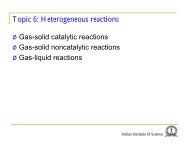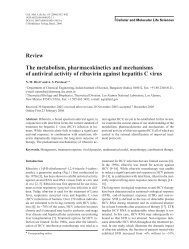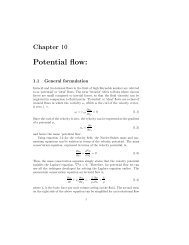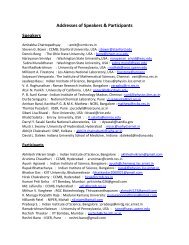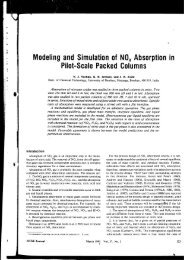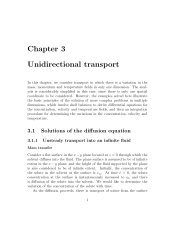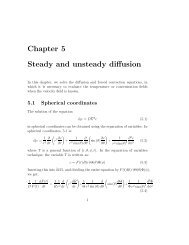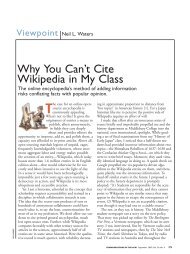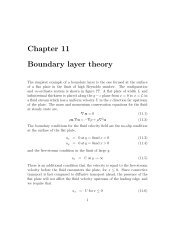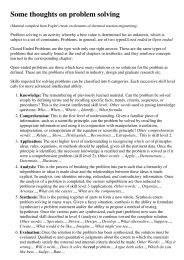Create successful ePaper yourself
Turn your PDF publications into a flip-book with our unique Google optimized e-Paper software.
24 CHAPTER 9. VISCOUS FLOW<br />
mass conservation equation.<br />
1 ∂(ru r )<br />
+ ∂u z<br />
r ∂r ∂z = 0 (9.93)<br />
The axial velocity u z can be scaled by the velocity of the surface of the sphere,<br />
U, since the axial velocity varies between 0 at the plane surface and −U at<br />
the surface of the sphere. When the mass conservation equation is expressed<br />
in terms of the scaled coordinates and the scaled velocity u ∗ z = (u z/U), we<br />
get<br />
1 1 ∂(r ∗ u r )<br />
+ U ∂u ∗ z<br />
Rǫ 1/2 r ∗ ∂r ∗ ǫR ∂z = 0 (9.94)<br />
∗<br />
The above equation provides the scaled for the radial velocity is u ∗ r = (u r ǫ 1/2 /U).<br />
This scaling indicates that when u ∗ r is O(1), the magnitude of the radial velocity<br />
is u r ∼ (U/ǫ 1/2 ), which is large compared to the magnitude of the axial<br />
velocity. This is because as the sphere moves downward, all the fluid displaced<br />
per unit time within a cylindrical section of radius r is πr 2 U. This fluid<br />
has to be expelled from the cylindrical surface with area 2πrh, and therefore<br />
the radial velocity scales as (Ur/h), which is proportional to (U/ǫ 1/2 ).<br />
The momentum conservation equations in the radial direction, expressed<br />
in terms of the scaled variables are<br />
ρU 2 ( ∂u<br />
∗<br />
r<br />
ǫ 3/2 ∂t + ∂u ∗<br />
∗ u∗ r<br />
r<br />
∂r + ∂u ∗ )<br />
∗ u∗ r<br />
z = − 1 (<br />
∂p U ∂ 2 u ∗<br />
∂z ∗ Rǫ 1/2 ∂r ∗+µ r<br />
R 2 ǫ 5/2 ∂z + U<br />
)<br />
1 ∂ r<br />
∗2 R 2 ǫ 3/2 r ∗ ∂r ∗r∗∂u∗ ∂r ∗<br />
(9.95)<br />
In the above equation, the scaled time has been defined as t ∗ = (tǫR/U),<br />
since the relevant time scale is the ratio of the gap width and the velocity<br />
of the sphere. This ensures that the first term on the left side of equation<br />
9.95 is of the same magnitude as the other three terms. The momentum<br />
conservation can be simplified by dividing throughout by the coefficient of<br />
the largest viscous term, which is proportional to (µU/R 2 ǫ 5/2 ),<br />
(<br />
ρURǫ ∂u<br />
∗<br />
r<br />
µ ∂t + ∂u ∗<br />
∗ u∗ r<br />
r<br />
∂r + ∂u ∗ )<br />
( ∗ u∗ r<br />
z = − Rǫ2 ∂p ∂ 2<br />
∂z ∗ µU ∂r + u ∗ r<br />
∗ ∂z + ǫ )<br />
∂ r<br />
∗2 r ∗ ∂r ∗r∗∂u∗ ∂r ∗ (9.96)<br />
This equation indicates that the scaled pressure should be defined as p ∗ =<br />
(pRǫ 2 /µU) for the pressure to be of the same magnitude as the viscous terms.<br />
Equation 9.96 also indicates that the appropriate Reynolds number in this<br />
case is (ρURǫ/µ), which is based on the gap thickness and the velocity of



